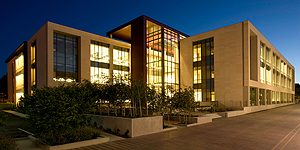 |
| The Lorry I. Lokey Stem Cell Research Building |
We’re in the middle of a big week for CIRM-funded research facilities. UCLA opened the doors to their new CIRM-funded stem cell research space Monday (here’s a video about that building) and today Stanford cuts the ribbon on the largest of the CIRM buildings – a gleaming 200,000 square-foot state-of-the-art facility. According to the Stanford press release about their Lorry I. Lokey Stem Cell Research Building:
The building’s 200,000 square feet of floor space, serving about 550 occupants, makes it the largest dedicated stem cell research building in the country, if not the world. But just as important, it was financed without any federal funding – buffering its occupants to some degree from the vagaries of embryonic stem cell politics.
The buildings are part of CIRM’s Major Facilities RFA, given out in May 2008 when federal funding could only be spent for stem cell research involving a small number of approved cell lines. That included working with unapproved lines in buildings created or supported through federal funds, which ruled out most available research space for work involving unapproved human embryonic stem cell lines. The CIRM buildings provide space free and clear for working with whichever stem cell lines scientists think will move the field toward new cures.
CIRM awarded $271 million to 12 institutions, each of which was required to raise additional funds through private donations. Altogether, CIRM’s investment brought in an additional $800 million in financial commitments and created construction jobs throughout the state at a time when those jobs were very much needed. This week’s building openings came about thanks to a $20 million donation to UCLA and a $30 million gift to USC by The Eli and Edythe Broad Foundation and a $75 million gift from Lorry I. Lokey to Stanford University.
Following today’s ceremony at Stanford, the University of Southern California will hold their grand opening Friday. Altogether, those three buildings created 322,000 square feet of new research space, all of it free of federal funding and therefore available for research into all types of stem cells regardless of what happens with the current court cases. This space has the capacity to house nearly 1,000 members of research teams.
Stanford gave a nice description of how having stem cell researchers housed together in well equipped space will speed the research that takes place. They quote Theo Palmer, who works on stem cell therapies for neurodegenerative diseases:
“We used to have to plan our day around getting our samples where they needed to be when they needed to be there. Now some of the best resources in the world are immediately available – including extraordinary cell-sorting capabilities and some of the most advanced single-cell genetic-profiling equipment. At other places in the country these resources are essentially not available, or available only by special arrangement.”
That time saved means CIRM grantees can work faster than ever toward new disease therapies.
-A.A.



